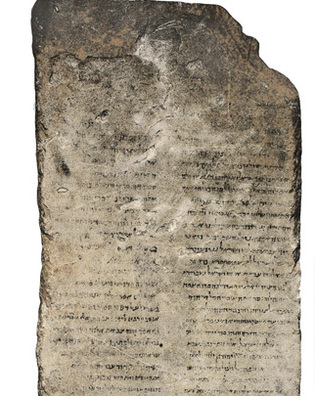 loading
loading
ForumThe Vision of GabrielAn ancient stone tablet stirs up controversy. John J. Collins, Holmes Professor of Old Testament Criticism and Interpretation at Yale Divinity School, has published widely on apocalyptic and messianic writings in Judaism.  Zev RadovanThe writing on this three-foot-high slab of gray limestone, if genuine, may date from around the time of Christ. It relates an apocalyptic vision addressed at least in part to the angel Gabriel. View full imageOn July 6, 2008, the New York Times published an article entitled "Ancient Tablet Ignites Debate on Messiah and Resurrection." The tablet in question is a slab of gray limestone, acquired by David Jeselsohn of Zurich about ten years ago. On it are written, in ink, some 87 lines of Hebrew. This text seems to be a revelation addressed at least in part to the angel Gabriel, and it has become known as "The Vision of Gabriel." It is not known just where or how the stone was found, though it is thought to come from the Jordanian side of the Dead Sea. The stone attracted little attention until it was shown to Ada Yardeni, a highly respected expert on ancient handwriting. Yardeni was convinced that the script dates from around the time of Christ, contemporary with the Dead Sea Scrolls. Other experts agree that the language and material of the stone are ancient. There are skeptics, nonetheless. Forgery of ancient inscriptions is a lucrative and sophisticated business in modern Israel, and whenever an artifact appears that has not been found in a legal excavation, doubts are inevitable. But for now, the text's authenticity must be given the benefit of the doubt. Yardeni and Binyamin Elitzur published the text in the Hebrew journal Cathedra in 2007. The controversy began after another Israeli scholar, Israel Knohl, argued in the Journal of Religion early in 2008 that the text describes a messianic figure, predating Jesus, who was expected to die and be raised from the dead after three days. Later Judaism has traditions about a dying messiah (the messiah of Ephraim, son of Joseph), but they are usually dated at least a century after the time of Jesus. At issue is the originality (and perhaps the historicity) of the Gospel story, and the possibility that the Jesus story was modeled on an earlier Jewish belief. This is not the first time that Knohl has tried to find a "messiah before Jesus." He published a book with that title in 2000, claiming that a fragmentary text in the Dead Sea Scrolls referred to a suffering messiah who would rise and be taken up to heaven. That book was not well received by scholars. Knohl now claims to be vindicated by the new evidence. But his reading of the Vision of Gabriel is highly conjectural and goes far beyond the evidence. Much of the text is extremely fragmentary, but there are several whole lines. A sample, beginning at line 13: It is apparent that the text is some kind of apocalyptic vision, of a type well known in the period 200 BCE to 100 CE; the Book of Revelation is the classic example. It promises deliverance for Jerusalem, and a role for a messiah of the line of David. We can usually date such texts by identifying the crisis from which deliverance is needed. (Several apocalypses were written after the Romans destroyed Jerusalem in 70 CE.) In the Vision of Gabriel, however, there is no clear allusion to any specific event. Knohl dates the text around the turn of the era, during the upheavals after Herod the Great died in 4 BCE. But the only evidence is the handwriting, and that does not provide a secure basis for such a precise date. Knohl regards "Ephraim" in this text as a reference to the "dying messiah" of rabbinic tradition. This would be the earliest mention of this figure. At line 67, he takes a reference to a chariot to mean that someone would be taken up to heaven. The main controversy, however, concerns line 80. Here Yardeni and Elitzur read "in three days," followed by the letter cheth. Knohl reads "by three days, live." It refers, he insists, to a messiah who was expected to rise after three days. At a conference in Jerusalem in early July, Knohl was met by skepticism from both Jewish and Christian scholars. The skepticism had nothing to do with theology. The text simply does not say what Knohl claims. It is too fragmentary. It is not clear that the Ephraim mentioned is a messiah. Even if the word after "three days" is "live," it does not follow that it means "rise from the dead." A chariot does not necessarily imply ascent to heaven. This is not to say that Knohl's interpretation is impossible. But there is not much reason to think it is right. But even if Knohl's interpretation were right, it would hardly warrant the ensuing fuss. Everyone who has taken an introductory New Testament course knows that the early Christians understood Jesus in light of Jewish prophecies and expectations. The motif of resurrection after three days is based on a passage from the prophet Hosea about restoration of the people: "on the third day he will raise us up that we may live before him." If Knohl's interpretation should prove to be right, it would be an interesting contribution to the history of religion. But its supposed threat to Christian theology is no more than a marketing strategy. In that respect, the Vision of Gabriel is only the latest of many discoveries that have been sensationalized for the sake of publicity.
The comment period has expired.
|
|